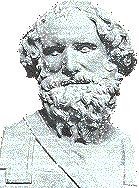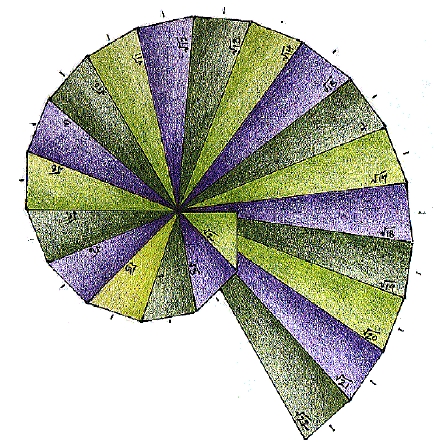|
  Introduction Introduction
This spiral was studied by Archimedes in about 225 BC in a work On Spirals.
Although it had already been considered by his friend Conon, it is often
called the Spiral of Archimedes. Archimedes
was able to work out the lengths of various tangents to the spiral.
Activity
 Supplies: index cards, rulers, pencils,
scissors, tool(see instructions below) Supplies: index cards, rulers, pencils,
scissors, tool(see instructions below)
 Calculations: simple scientific calculator (for
example TI-34) Calculations: simple scientific calculator (for
example TI-34)
Making the Tool
The tool used in this exercise is made from a 4 by 6 sq. in. index card with
one inch marked on its short side. This tool is used to draw right triangles
that have one leg which is one inch long.
Task 1.
Draw a spiral built from right triangles that have one leg 1 inch long. (See
picture.) Start with a right triangle that has both legs 1 inch long. Using
the tool, draw the next triangle, starting with the hypotenuse of the
previous one. Stop before the triangles overlap.
Remark:
Show students how to use the tool efficiently. Precision is important;
students must use sharp pencils and draw lightly. At the very end they may
color and decorate their drawings.
Task 2.
Measure the rays radiating from the center of the spiral. Form the table as
follows. (The numbers below were taken from a specific drawing.)
|
number of radius, n:
|
length in inches:
|
decimal equivalent:
|
square root of number n:
|
|
1
|
1
|
1
|
1
|
|
2
|
1 7/16
|
1.4375
|
1.4142
|
|
3
|
1 13/16
|
1.813
|
1.732
|
|
4
|
2
|
2
|
2
|
|
5
|
2 5/16
|
2.313
|
2.236
|
|
6
|
2 9/16
|
2.563
|
2.449
|
|
7
|
2 3/4
|
2.750
|
2.645
|
|
8
|
2 15/16
|
2.938
|
2.828
|
|
9
|
3 1/16
|
3.063
|
3.000
|
|
...
|
...
|
...
|
...
|
|
16
|
4
|
4
|
4
|
Compute the decimal equivalents in the table as follows:
1 13/16 is computed by
[13] [/] [16] [+] [1] [=].
|
Explanation
The n-th triangle has legs with length √n and 1 inches, and
hypotenuse √(n+1) inches, by the Pythagorean Theorem.
|
Remark:
If students do not know the Pythagorean Theorem, this may be its first
introduction.
Question:
How fast does the spiral curl
around?
Solution:
Adding the n-th triangle increases the angle by arctan (1/√n). Thus, for each n up to some chosen
number n’, compute arctan(1) + arctan(1/√2) + ... + arctan(1/√n’). Make a table of values, and compare
them with the angles measured on your drawing.
The program (using a TI-34II calculator)
[2nd][FIX][0]
OP1=A+1→A
OP2=B+tan-1(√(A)-1→B
Now initialize variables A and B:
0→A
0→B
Now run the program:
Repeat
OP1
OP2
Each OP2 on the display gives the new angle. Record the values in a table.
Example Table:
|
n:
|
angle in degrees:
|
|
1
|
45
|
|
2
|
80
|
|
3
|
110
|
|
4
|
137
|
|
5
|
161
|
|
6
|
183
|
|
7
|
204
|
|
8
|
223
|
|
...
|
...
|
|

